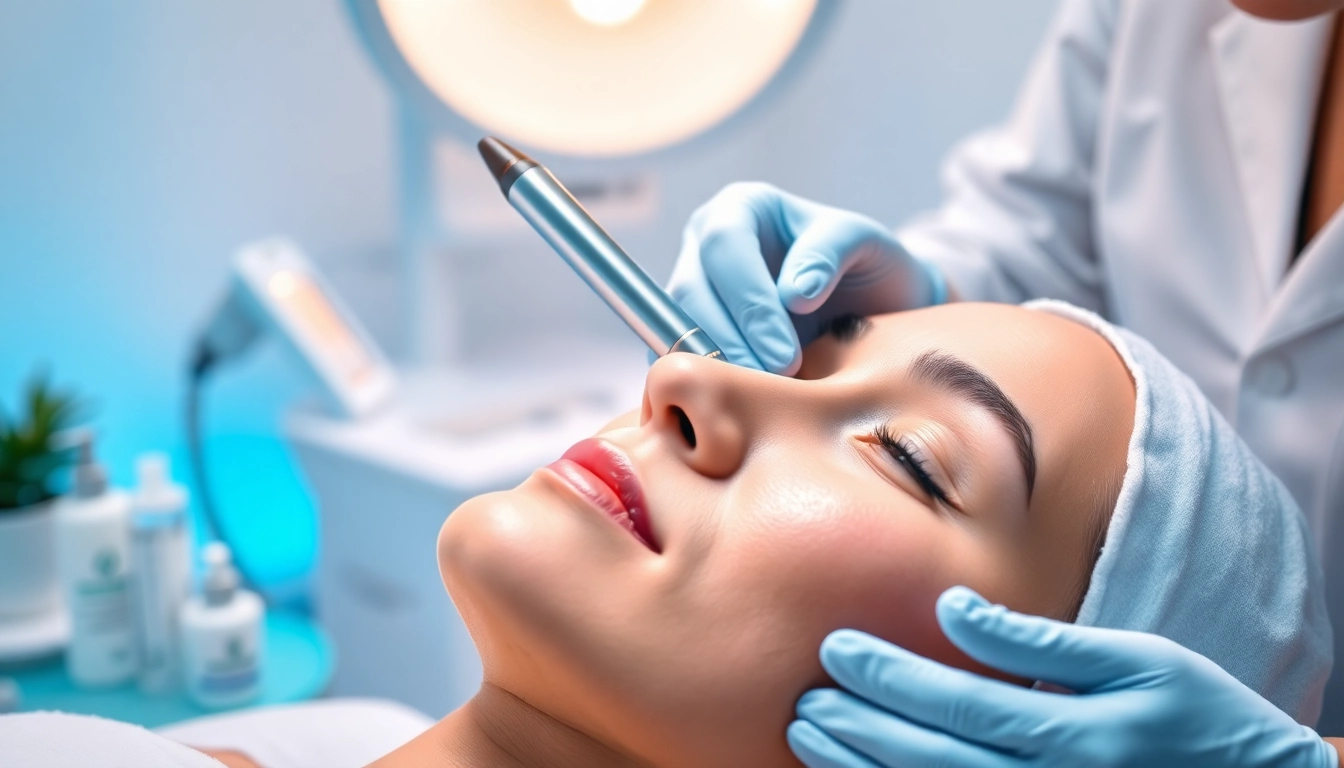Understanding RF Microneedling
What is RF Microneedling?
RF microneedling is an innovative cosmetic procedure that combines traditional microneedling techniques with the power of radiofrequency energy. This dual-action approach not only creates micro-injuries in the skin through tiny needles but also delivers targeted radiofrequency energy deep into the dermis. The heat generated by the radiofrequency stimulates the natural production of collagen and elastin, essential proteins that improve skin elasticity and texture.
The treatment is gaining popularity for its ability to address a variety of skin concerns, including fine lines, wrinkles, acne scars, and skin laxity. Patients can expect noticeable improvements in skin appearance after several sessions, making it a sought-after option for those looking for non-surgical skin rejuvenation. You can learn more about the technique and its advantages at RF microneedling.
How RF Microneedling Works
During an RF microneedling session, a trained practitioner uses a handheld device equipped with fine needles that can penetrate the skin at various depths. As these needles create micro-injuries, the attached radiofrequency component activates, delivering energy to the surrounding skin tissue. This combination enhances the body’s natural healing process, prompting the skin to rebuild itself with new collagen and elastin.
The procedure begins with a thorough cleansing of the skin, followed by the application of a topical anesthetic to minimize discomfort. The practitioner then carefully moves the device across the targeted areas, adjusting the settings based on the specific needs of the patient and the treatment area. Each session typically lasts between 30 to 90 minutes, depending on the extent of the treatment.
Comparison to Traditional Microneedling
Traditional microneedling involves the use of a mechanical device or a manual pen to create thousands of tiny punctures in the skin. While this stimulates collagen production, RF microneedling takes it a step further by heating the deeper layers of the dermis. This added heat can enhance the overall results, leading to increased skin tightening and improved texture compared to traditional methods.
Moreover, traditional microneedling primarily focuses on the outer layer of the skin, while RF microneedling appeals to those looking for deeper rejuvenation and improved results regarding sagging skin and pronounced scars. This makes RF microneedling a more versatile and effective option for various skin conditions.
Benefits of RF Microneedling
Skin Tightening and Lifting
One of the standout benefits of RF microneedling is its ability to promote skin tightening and lifting. The radiofrequency energy penetrates deeply, stimulating collagen and elastin production, which helps to improve skin firmness and elasticity. Patients often report a more toned appearance in treated areas, which can be especially beneficial for those experiencing sagging skin due to aging or weight loss.
Clinical studies have shown that RF microneedling can lead to significant improvements in skin laxity, making it an attractive alternative to surgical procedures like facelifts, particularly for individuals seeking non-invasive options.
Reducing Scars and Pigmentation
RF microneedling is also effective in reducing the appearance of scars and hyperpigmentation. The micro-injuries created during the treatment stimulate healing processes in the skin, helping to break down scar tissue and promote the growth of healthier tissue. This process can lead to a significant reduction in the visibility of acne scars, surgical scars, and other irregularities in skin tone and texture.
Furthermore, the improved collagen synthesis and skin regeneration can help to even out skin tone, making it a favorable option for treating pigment-related issues.
Enhancing Overall Skin Quality
Beyond targeted concerns like skin laxity and scarring, RF microneedling enhances overall skin quality by improving texture and radiance. The combination of microneedling and radiofrequency energy prompts the body to regenerate skin cells and rejuvenate the complexion. Patients often notice a smoother, more youthful appearance characterized by fewer fine lines and wrinkles and a more vibrant skin tone.
The treatment can also lead to improved skin hydration, as the micro-channels created during the procedure can enhance the absorption of topical skincare products. Thus, incorporating RF microneedling into a regular skincare routine can significantly enhance the efficacy of serums and moisturizers.
Preparing for RF Microneedling
Consultation and Pre-Treatment Steps
Preparation for RF microneedling begins with a thorough consultation with a licensed practitioner. During this stage, practitioners assess the patient’s skin type and concerns, discuss treatment goals, and evaluate any potential contraindications such as skin conditions or medications that may affect healing.
Patients may be instructed to avoid certain medications, such as blood thinners, and to stop using retinoids or other active ingredients a few days before the procedure. A pre-treatment skincare regimen may also be recommended to optimize skin health leading up to the session.
What to Expect During the Procedure
On the day of the procedure, patients arrive with clean skin, free from makeup or any other products. After the application of a topical anesthetic to minimize discomfort, the practitioner selects the appropriate needle depth and radiofrequency settings based on the patient’s unique skin needs. The procedure typically lasts between 30 to 90 minutes.
Most patients describe the sensation as a mild prickling or heating feeling rather than pain. Post-treatment, some redness and swelling are common, similar to a mild sunburn, but these effects typically subside within a few days.
Post-Treatment Care Guidelines
Post-treatment care is crucial for optimizing results and minimizing potential complications. Patients are usually advised to avoid sun exposure and to use broad-spectrum sunscreen for at least a week post-treatment. Additionally, gentle skincare products should be prioritized, avoiding any harsh exfoliants or active ingredients for a designated timeframe.
Drinking plenty of water and maintaining hydration can support the healing process, and some practitioners may recommend specific serums or creams to enhance recovery further. Following these guidelines will help ensure the best possible results and minimize any downtime associated with the procedure.
Common Myths and Misconceptions
Myth: RF Microneedling is Painful
Many potential patients hesitate to undergo RF microneedling due to fears of pain. However, the majority of individuals report that the discomfort is minimal, primarily due to the numbing agents applied before the procedure. While some may experience mild discomfort as the needles penetrate the skin, it is usually well-tolerated and significantly less intense than anticipated.
Myth: Results are Instant
Another common misconception is that RF microneedling provides immediate results. While some patients may notice an initial improvement in skin quality immediately post-treatment, the most significant results emerge gradually as collagen and elastin production ramps up within the weeks following the procedure. Optimal outcomes are typically seen after a series of treatments.
Myth: Only for Older Adults
RF microneedling is often perceived as a treatment exclusively for older adults dealing with sagging skin or wrinkles. In reality, individuals of various ages can benefit from this treatment. Younger patients with acne scars or those aiming for preventive measures can also find value in RF microneedling. It is a versatile option for a wide range of skin types and concerns.
Finding the Right RF Microneedling Provider
Questions to Ask During Consultations
When considering RF microneedling, finding the right provider is essential. During initial consultations, patients should inquire about the practitioner’s qualifications and experience with this specific procedure. Questions about the number of treatments performed and patient outcomes can help gauge the provider’s expertise. It’s also important to understand the technology and equipment being used during the sessions.
Evaluating Practitioner Experience and Equipment
Beyond qualifications, evaluating the practitioner’s experience with RF microneedling specifically can be beneficial. Providers should not only be licensed but also should have completed specific training in RF microneedling techniques. Additionally, it’s vital to inquire about the types of devices used, ensuring they are up-to-date and backed by clinical research showing safety and efficacy.
Reading Reviews and Testimonials
Reading patient reviews and testimonials can provide valuable insights into the quality of care and outcomes experienced by others. Look for patterns in feedback regarding results, comfort during the procedure, and the overall experience with the provider and their staff. Honest testimonials can offer prospective patients a realistic expectation of what to anticipate during and after treatment.



